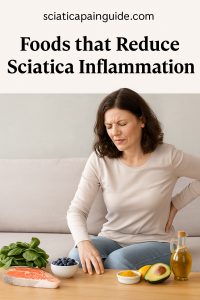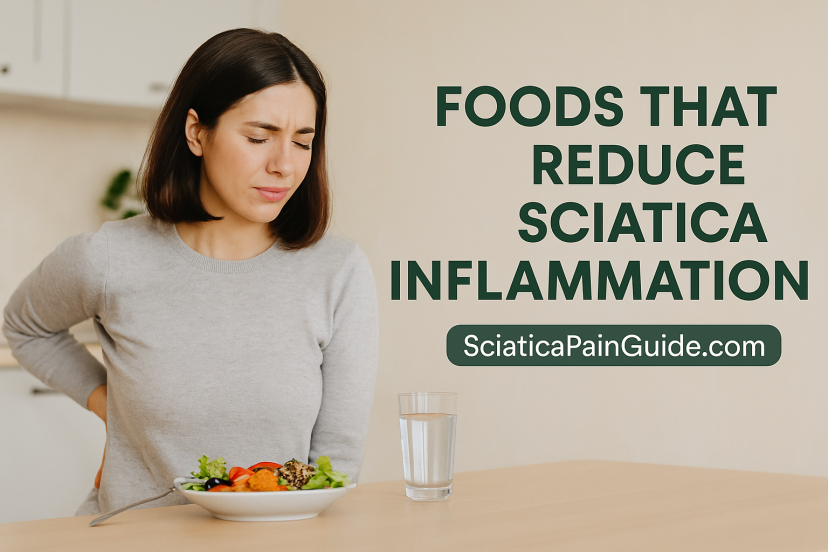Foods That Reduce Sciatica Inflammation – Natural Nutrition for Nerve Pain Relief and Recovery
⚡ Living with Sciatica Pain: Why Diet Matters
If you’ve ever felt a sharp, burning pain travel down your lower back, through your hip, and into your leg — you know how disabling sciatica can be. It can make simple tasks like walking, sitting, or even sleeping a daily challenge.
Most people focus on stretches, medications, or therapy to find relief. But there’s another key factor that often goes overlooked — what you eat.
Inflammation is at the heart of most sciatica flare-ups. By following a nerve-friendly, anti-inflammatory diet, you can help your body calm irritation, reduce swelling around the sciatic nerve, and accelerate recovery naturally.
Let’s explore the top foods that reduce sciatica inflammation — and what to avoid for faster, lasting relief.
🧠 Understanding the Link Between Inflammation and Sciatica
Sciatica pain occurs when the sciatic nerve (the largest nerve in the body) is compressed or inflamed. While causes like herniated discs, bone spurs, or muscle tension can trigger the pain, chronic inflammation amplifies it.
When your body is inflamed:
-
Nerves become more sensitive and reactive
-
Swelling increases pressure on nearby tissues
-
Pain signals intensify
That’s why eating the right foods — those rich in antioxidants, omega-3 fatty acids, vitamins, and minerals — can reduce nerve irritation and promote long-term healing.
🥦 Top Anti-Inflammatory Foods That Reduce Sciatica Inflammation
1. 🐟 Fatty Fish (Salmon, Sardines, Mackerel)
Fatty fish are among the best anti-inflammatory foods thanks to their high content of omega-3 fatty acids (EPA and DHA). These healthy fats lower inflammation markers like CRP (C-reactive protein) and support nerve membrane repair.
U.S. Tip: Wild-caught salmon from Alaska or sardines packed in olive oil are great options.
How to eat: 2–3 servings per week — grilled, baked, or in fish tacos.
2. 🌿 Turmeric and Curcumin
Turmeric, a golden spice used for centuries, contains curcumin, a powerful anti-inflammatory compound that helps reduce pain and stiffness.
Studies show curcumin blocks the same inflammatory pathways targeted by NSAIDs — but naturally.
Quick use:
-
Add ½ teaspoon to smoothies, eggs, or tea
-
Pair with black pepper to improve absorption (piperine boosts bioavailability by up to 2,000%)
U.S. Supplement Pick: Nature Made Turmeric Curcumin 500 mg (widely available at CVS or Amazon).
3. 🥬 Leafy Greens (Spinach, Kale, Swiss Chard)
Leafy greens are rich in magnesium, folate, and antioxidants that protect nerve cells and reduce oxidative stress. Magnesium also helps relax muscles — a key factor when the sciatic nerve is compressed.
Try this: Spinach omelet for breakfast or kale salad with olive oil and avocado for lunch.
4. 🍒 Berries (Blueberries, Strawberries, Blackberries)
Packed with anthocyanins and vitamin C, berries fight free radicals that damage nerve tissue.
They also support collagen formation — important for maintaining healthy spinal discs.
Smart snack: Frozen blueberries in Greek yogurt or added to oatmeal.
5. 🥑 Avocados
Avocados are loaded with monounsaturated fats, vitamin E, and potassium — all essential for nerve repair and anti-inflammatory support.
They also stabilize blood sugar, which helps prevent inflammatory spikes throughout the day.
Easy idea: Spread mashed avocado on whole-grain toast or add slices to a turkey sandwich.
6. 🫒 Extra Virgin Olive Oil
Olive oil contains oleocanthal, a natural compound that acts like ibuprofen to lower inflammation.
Drizzle it over salads, vegetables, or use it as your main cooking oil.
Choose: Cold-pressed, extra virgin varieties like California Olive Ranch for maximum polyphenol content.
7. 🌰 Nuts and Seeds (Walnuts, Chia, Flaxseeds)
These foods are rich in omega-3s and alpha-linolenic acid (ALA), which help reduce inflammation and nerve stress.
They also provide fiber, helping maintain a healthy weight — another key factor since extra pounds can strain the lower back.
Snack smart: Mix almonds and walnuts with dried cherries for a nerve-friendly trail mix.
8. 🍠 Sweet Potatoes
A powerhouse of beta-carotene, vitamin C, and fiber, sweet potatoes help regulate inflammation and blood sugar levels.
They’re also a great substitute for white potatoes, which may trigger inflammation in sensitive individuals.
Quick tip: Bake with olive oil and rosemary for an easy anti-inflammatory side dish.
9. 🍵 Green Tea
Green tea contains EGCG (epigallocatechin gallate) — a potent antioxidant that helps reduce inflammation and oxidative stress.
It may also improve circulation to nerve tissues, supporting healing.
Best practice: Drink 1–2 cups daily, hot or iced. Matcha versions contain even more antioxidants.
10. 🧄 Garlic and Onions
Both are packed with sulfur compounds that suppress inflammatory pathways. They also support immune health, which helps the body fight underlying causes of nerve pain.
Add them: To soups, sauces, or roasted vegetables for flavor and relief.
🚫 Foods to Avoid for Sciatica Inflammation
If you’re serious about reducing inflammation, what you avoid is just as important as what you eat.
❌ Limit These Inflammatory Triggers
-
Processed foods (chips, white bread, pastries)
-
Refined sugars (sodas, desserts, flavored coffee drinks)
-
Fried and fast foods (trans fats worsen inflammation)
-
Excess red or processed meats (bacon, hot dogs)
-
Dairy or gluten (for those with sensitivities)
-
Alcohol and smoking (both heighten nerve sensitivity)
👉 Try an elimination approach: remove one category for 2–3 weeks and observe improvements in pain and energy.
💪 Example 1-Day Anti-Inflammatory Meal Plan for Sciatica Relief
| Meal | Example | Key Nutrients |
|---|---|---|
| Breakfast | Spinach and mushroom omelet cooked in olive oil + green tea | Magnesium, antioxidants |
| Snack | Handful of walnuts + blueberries | Omega-3s, anthocyanins |
| Lunch | Grilled salmon over quinoa salad with kale and avocado | Omega-3s, fiber, vitamin E |
| Snack | Turmeric smoothie with almond milk and chia seeds | Curcumin, calcium |
| Dinner | Baked sweet potatoes, garlic roasted veggies, and herbal tea | Vitamin C, beta-carotene |
Consistent eating like this can make a measurable difference in nerve inflammation within weeks.
🧘♀️ Supporting Sciatica Recovery Beyond Diet
Food lays the foundation, but combining it with healthy lifestyle habits accelerates healing.
✅ Try This 3-Step Daily Routine
-
Gentle Movement:
Morning stretches or short walks keep blood flowing to the sciatic nerve. -
Posture Check:
Use a lumbar support cushion while sitting or a standing desk to reduce compression. -
Quality Sleep:
The body repairs inflammation during deep rest — try sleeping on your side with a pillow between your knees.
⚠️ When to See a Doctor
While diet can greatly reduce inflammation and support recovery, you should consult a healthcare professional if:
-
Pain lasts longer than 8 weeks
-
You experience leg weakness, numbness, or tingling
-
Pain interferes with walking or sleep
-
You have bowel or bladder changes
-
Over-the-counter treatments aren’t helping
A doctor may recommend physical therapy, chiropractic adjustments, or advanced imaging (MRI) to check for nerve compression.
❓ Common FAQs About Foods That Reduce Sciatica Inflammation
1. Can diet really help sciatica pain?
Yes! A consistent anti-inflammatory diet lowers swelling around the sciatic nerve, reducing pressure and pain over time.
2. What is the best anti-inflammatory food for sciatica?
Fatty fish like salmon, turmeric, and leafy greens are top choices for fighting nerve inflammation.
3. How long does it take to see results from dietary changes?
Most people notice improvement in 2–4 weeks, but consistent habits yield long-term relief.
4. Can certain vitamins help nerve repair?
Yes — vitamins B12, D, and magnesium are essential for nerve regeneration and muscle relaxation.
5. Is coffee bad for sciatica?
Moderate coffee is fine, but excessive caffeine can dehydrate tissues and increase inflammation for some individuals.
6. What foods worsen nerve pain?
Sugar, fried foods, and processed snacks can trigger inflammation and intensify nerve sensitivity.
7. Can supplements replace an anti-inflammatory diet?
No — supplements can help, but whole foods provide a complex mix of nutrients that pills can’t match.
🌈 Conclusion: Heal Your Nerves from the Inside Out
Your daily meals can either feed inflammation or fuel healing. By embracing foods that reduce sciatica inflammation — like fatty fish, leafy greens, turmeric, and berries — you’re giving your body the nutrients it needs to calm pain naturally and support long-term recovery.
Consistency is key. Combine an anti-inflammatory diet with gentle movement, posture awareness, and good rest, and you’ll notice a steady improvement in how your body feels and moves. 🌿
🩺 “Every bite you take can bring you one step closer to healing.”
⚕️ Medical Disclaimer
This article is for informational purposes only and should not replace professional medical advice. Always consult your healthcare provider before making significant dietary or lifestyle changes, especially if you have chronic conditions or take medication.

- Best Shoes for Walking with Sciatica
- Sciatica from Lifting Heavy Objects
- Sciatic Nerve Stretches to Relieve Pain





